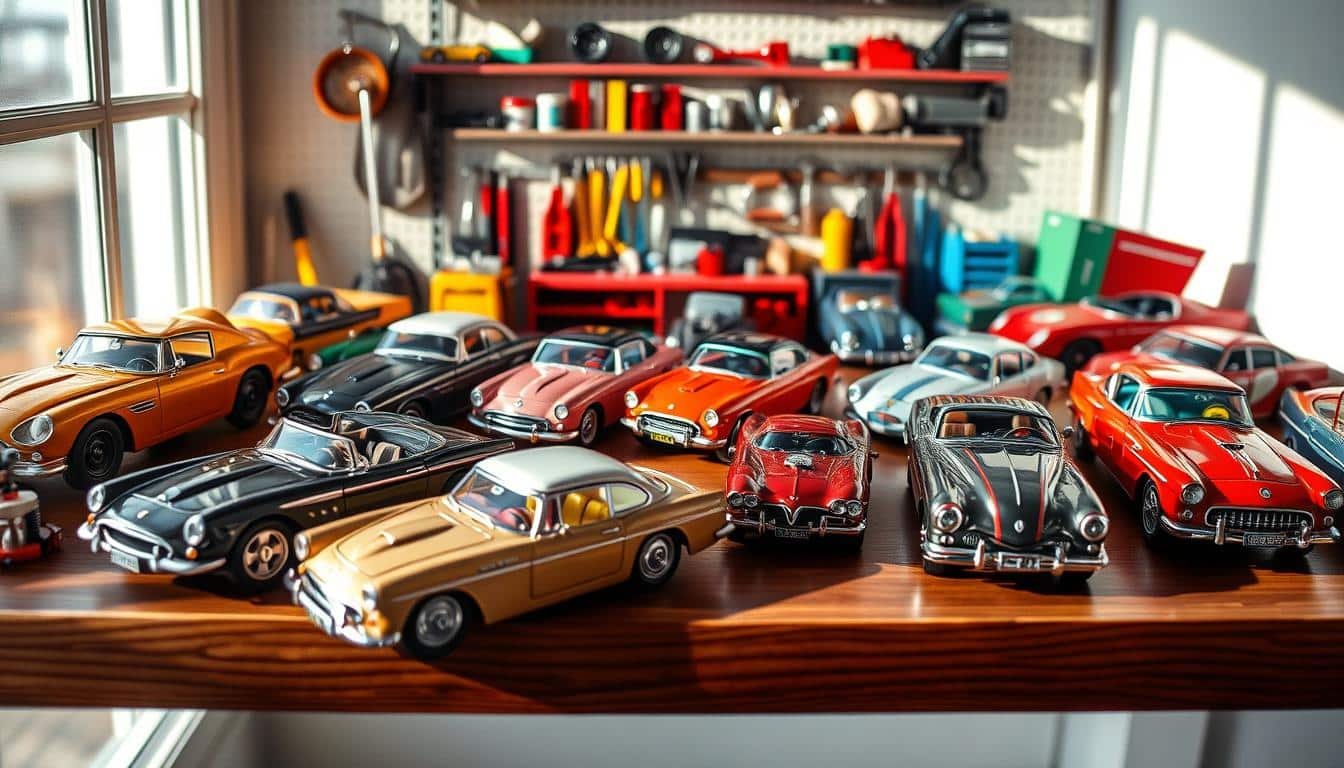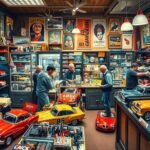I’ve always been drawn to diecast cars. These small vehicles are made with amazing detail. They’ve won the hearts of collectors worldwide. As a kid, I loved opening a new diecast model and feeling the metal.
My collection has grown over time. It includes everything from old cars to modern supercars. Each model has its own story, capturing moments in car history or personal memories. Diecast cars bring together passion, art, and nostalgia.
Some diecast cars are incredibly valuable. For example, a 1:8 scale model by Robert Gulpen Engineering can cost up to $6 million. There’s also a golden version worth $7.5 million and a 24K gold model by Robert Gulpen and Stuart Hughes for $2.9 million. These prices show how much these tiny cars are worth.
Diecast cars mean a lot to collectors. They connect us to the world of cars, even if we can’t own the real thing. The excitement of finding a rare model and sharing it with others makes collecting special.
Key Takeaways
- Diecast cars are highly detailed miniature replicas of real vehicles.
- Collectors value diecast cars for their craftsmanship, rarity, and connection to automotive history.
- Some rare and limited-edition diecast models can fetch millions of dollars.
- Collecting diecast cars is a passion that brings enthusiasts together to share their love for these miniature marvels.
- Diecast cars serve as tangible connections to the automotive world, allowing collectors to own a piece of their favorite vehicles.
What Is a Diecast Car?
Diecast cars are detailed scale replicas of real vehicles. They are made through a special process called die casting. This method uses molten metal, like zinc and aluminum, to fill a precise mold under high pressure.
The outcome is a strong, accurate metal casting. It captures the look of the original vehicle in a small size.
These precision models come in different scales. You can find them in sizes like 1:18, 1:24, 1:43, and 1:64. This lets collectors pick the size that fits their space and taste.
Smaller scales, like 1:64, are great for big collections. Larger scales, like 1:18, show off more detail for special pieces.
Key Characteristics of Diecast Cars
Diecast cars are known for their detailed look. They accurately copy the real car’s shape, design, and features. From the detailed grilles and headlights to the exact interior, they give a close-up look at car design.
The use of metal castings makes these cars feel heavy and durable. This is different from plastic models. It means they last longer and can handle more wear and tear, making them perfect for play or display.
There’s a wide range of diecast cars available. You can find classic muscle cars, vintage racers, modern supercars, and even cars from movies and TV. Diecast cars are a fun and rewarding hobby for people of all ages.
The History of Diecast Cars
Diecast cars have been around for over a century. They started in the early 1900s. These small models quickly won the hearts of kids and adults.
Dinky Toys was one of the first big names in diecast cars. They began in the early 1900s. Their models included sports cars, trucks, and tractors. This set the stage for the wide variety of diecast cars we see today.
Origins and Development
The Model T and MG sports cars were among the first to be made into diecast models. Toy makers saw how popular cars were becoming. These early models were simple but started the trend for detailed diecast cars.
“The early model car industry dates back to the late 1800s, with diecast model cars beginning to take shape in the early 1900s after the emergence of a new die-casting technique during World War I.”
Evolution Over the Decades
In the 1930s, diecast cars got more realistic. Brands like Corgi Toys stood out by using glazed plastic windows. This made their models look even more like real cars.
| Decade | Notable Developments |
|---|---|
| 1950s-1960s | Diecast car production boom, iconic brands emerge (Dinky Toys, Corgi, Matchbox) |
| 1968 | Mattel introduces Hot Wheels, prioritizing sleek designs and racing functionalities |
| 1970s-1980s | Shift towards adult collectors seeking authentic, highly detailed replicas |
In the 1960s, collecting diecast cars became super popular. Brands like Matchbox and Hot Wheels were everywhere. Today, people still love collecting these tiny cars, looking for rare and special ones.
Materials Used in Diecast Cars
Diecast cars are loved by collectors for their detailed look and lasting quality. They are made from metal alloys like zinc and aluminum. These materials help make models that look just like real cars.
Diecast Metal vs. Other Materials
Early diecast toys were made from many materials, including metal, plastic, rubber, and glass. But now, the focus is on specific metal alloys. Lead alloy was first used, but Zamak (a zinc alloy) is more common today. Zamak is strong and can be shaped easily, perfect for making diecast models.
Diecast models also use plastic for parts like wheels, doors, and windows. Rubber is used for the wheels to give them grip and make them look more real.
Advantages of Diecast Construction
The die casting process has many benefits. It’s great for making detailed and high-quality diecast cars:
- It can create complex shapes with fine details
- It ensures consistent quality in every model
- It’s cost-effective for making lots of models
- It makes the models last a long time
Using metal alloys like zinc and aluminum, along with plastic and rubber, makes diecast cars stand out. They are detailed and durable. This is why collectors love them so much.
| Material | Purpose |
|---|---|
| Zinc alloy (Zamak) | Main body, chassis |
| Aluminum alloy | Lightweight components |
| Plastic | Intricate parts (wheels, doors, windows) |
| Rubber | Tires, grip, traction |
Popular Diecast Car Brands

Several brands have made a lasting impact in the world of diecast cars. They offer detailed and crafted models that collectors love. Each brand has its own style, scale, and focus, winning hearts worldwide.
Hot Wheels, founded in 1968 by Mattel Inc. in the United States, is a top name. They are known for their bright designs and track sets. Their Redline Series, from 1968 to 1977, is especially popular for its “Spectraflame” paint and vintage look.
Hot Wheels
Hot Wheels mainly makes 1:64 scale models but also offers 1:43 and 1:18 sizes. They have a wide range of vehicles, from classic cars to supercars. Their quality and creativity have made them famous, with over 6 billion cars sold.
Matchbox
Matchbox, started in 1953 in the United Kingdom, is another well-loved brand. They focus on 1:64 scale diecast cars, with many types like classic cars and trucks. Their realistic designs and attention to detail make them a favorite among collectors.
Dinky Toys
Dinky Toys, founded in the 1930s in the United Kingdom, is one of the oldest and most respected brands. They are famous for their pre-war racing cars and military vehicles. Although they stopped making cars in 1979, their legacy lives on in vintage collections and among enthusiasts.
| Brand | Founded | Country | Primary Scales |
|---|---|---|---|
| Hot Wheels | 1968 | USA | 1:64, 1:43, 1:18 |
| Matchbox | 1953 | UK | 1:64 |
| Maisto | 1967 | USA | 1:18, 1:24, 1:64 |
| Bburago | 1974 | Italy | 1:18, 1:24, 1:43 |
Other brands like Maisto, Bburago, and Siku also stand out. Maisto offers a wide range of scales and types. Bburago focuses on detailed classic and modern sports cars. Siku provides realistic models of cars, trucks, and agricultural vehicles. Each brand adds something special to the world of diecast cars, giving collectors many options for their collections.
Understanding Scale Models
Collecting diecast cars means knowing about scale. Scale shows how big a model car is compared to the real thing. These small models let collectors show off their favorite cars in a neat way.
Choosing a scale depends on what you like, how much space you have, and how much detail you want. Smaller scales like 1:64 are great because they’re easy to store and don’t cost much. These tiny cars are about 2¾ inches long and ¾ inch tall, perfect for big collections.
Larger scales like 1:18 and 1:24 offer more detail. They’re for adult collectors who want to see the car’s details up close. An 18-scale car is about 9½ inches long and 3 inches tall, costing between $150 and $300.
Common Scales in Diecast Cars
There are many scales for diecast cars, but 1:64, 1:24, and 1:18 are the most popular. The 1:43 scale is also widely collected, with cars about 4¾ inches long and 1 inch tall. These models cost between $100 and $150.
For bigger models, the 1:12 scale is impressive. These cars are 14½ inches long and 4 to 4½ inches tall, costing between $300 and $700. They show off the car’s details in a big way.
| Scale | Approximate Size | Price Range |
|---|---|---|
| 1:64 | 2¾” long, 1″ wide, ¾” tall | $15 – $40 |
| 1:43 | 4¾” long, 1¾” wide, 1″ tall | $100 – $150 |
| 1:24 | 7½” long, 3″ wide, 2¼” tall | $50 – $150 |
| 1:18 | 9½” long, 4″ wide, 3″ tall | $150 – $300 |
| 1:12 | 14½” long, 5½” wide, 4-4½” tall | $300 – $700 |
Scale choices can also depend on the type of vehicle. For example, 1:50 scale is common for trucks and buses. 1:87 scale is popular in the USA and Europe, matching HO scale model trains.
Knowing about different scales helps collectors choose based on their interests and needs. Whether you like the small charm of 1:64 or the big detail of 1:12, there’s a scale for everyone.
The Art of Collecting Diecast Cars
Collecting diecast cars is a favorite hobby for many. It spans over a century of car history, offering a wide range of models. For some, these small cars bring back fond memories. Others love the detailed craftsmanship of each piece.
Why People Collect
Collectors have different reasons for their passion. Some love cars and see these models as a way to own their favorites. Others enjoy searching for rare models to add to their collection. Serious collectors often focus on a specific theme or type of car.
Building a large collection takes time, but it’s rewarding. Collectors value the history and innovation in each model. It’s a journey that’s as fulfilling as the end result.
Displaying Your Collection
Displaying your diecast cars is key once you start collecting. Some use simple shelves or bookcases. Others prefer special display cases to protect and showcase their models.
| Display Option | Advantages |
|---|---|
| Wall-mounted shelves | Space-saving, easily customizable |
| Glass display cases | Protection from dust and damage, elegant presentation |
| Acrylic display stands | Affordable, stackable, allows for 360-degree viewing |
Choosing how to display your collection is important. The goal is to show off the beauty and uniqueness of each model. By doing so, you can fully enjoy the artistry and nostalgia they represent.
How to Care for Diecast Cars
As a collector of diecast model cars, I know how important it is to take care of them. These models can get dusty and even deteriorate if not handled right. I’ll share my tips for cleaning and maintaining your diecast cars so they stay beautiful for years.
Cleaning Techniques
Before you start cleaning, check the model’s design and condition. There are three cleaning types: dusting, general cleaning, and deep cleaning.
- Dusting: Use a soft brush or microfiber cloth to prevent grime buildup. Clean every 3-6 months if your environment is dust-free.
- General Cleaning: If your environment is dustier or you handle your models often, clean every 1-3 months. Use cotton cloths, mild soap, and soft tools.
- Deep Cleaning: For valuable models or tough grime, a car bath might be needed. Use lukewarm water with mild soap for 30 seconds, then dry carefully to avoid rust.
Avoid using household cleaning products or harsh chemicals on diecast models to prevent damage to paint or materials.
Maintaining Value
Proper care and storage are crucial for your diecast collection’s value. Here are some tips to keep your models in great shape:
| Tip | Description |
|---|---|
| Regular Cleaning | Clean your models every 1-6 months, depending on the environment and handling frequency. |
| Gentle Handling | Always handle your models with clean, dry hands to avoid transferring oils or dirt. |
| Proper Materials | Use soft brushes, microfiber cloths, and mild soap for cleaning. Avoid harsh chemicals or abrasive materials. |
| Storage Solutions | Store your models in a clean, cool place away from direct sunlight, preferably in a display case or box with a soft lining. |
By following these care and maintenance guidelines, your diecast model cars will stay in excellent condition. They will retain their value and impress collectors for years.
Diecast Car Shows and Events

Diecast car shows are a thrill for collectors. They offer a chance to meet others who love miniature cars. You can find rare models and learn about new ones.
Where to Find Diecast Shows
There are many ways to find diecast car shows. Local hobby shops often have info on upcoming events. Online forums and collector clubs are also great places to find out about shows. Some notable events include:
- The North Dallas Toy Show, with over 100 vendor tables
- The GCHWC Diecast Show, where vendors can rent tables for $10 each and admission is $3
Benefits of Attending Events
Diecast car shows offer many benefits. You can meet other collectors and share knowledge. Workshops and seminars provide valuable insights into the hobby.
Shows are also great for buying, selling, or trading models. You can find rare pieces and ensure the quality of your purchases.
| Event | Date | Winner | Host |
|---|---|---|---|
| EPVIDEOS Tournament | 11/28/24 | RLoRacing | EPVIDEOS |
| Run With The Big Dogs Chained Group | 11/23/24 | Numbskull | Bent_Rod_Racing |
| First unofficial Race | 11/18/24 | Dog_Squab_Racing | – |
| Deep Eddy Street Takeover | 11/16/24 | LIVE YOUNG DIE-CAST | – |
| XR Four Seasons Rally | 10/31/24 | PuffsRacing | XR Diecast Racing |
Diecast car shows also offer a chance to meet industry professionals. This can lead to exclusive models or early info on new releases.
Attending diecast car shows has been a game-changer for me as a collector. The wealth of knowledge and camaraderie I’ve experienced at these events is truly invaluable.
In summary, diecast car shows and events are key for collectors. They provide a chance to connect with others, grow your collection, and appreciate the artistry of these miniature marvels.
How to Value Diecast Cars
As a diecast car collector, knowing your collection’s value is key. Several factors affect these miniature models’ worth. Knowing them helps you make smart choices when buying, selling, or appraising.
Factors Influencing Value
There are four main factors to consider when valuing diecast cars: rarity, condition, age, and demand. Rare and perfect models usually cost more. For instance, high-end models are pricey because of their craftsmanship, limited production, and exclusivity.
Older, vintage models can also be more valuable. This is especially true if they’re rare or have historical importance. Diecast cars became popular in the early 20th century. They showcased a wide range of automotive history in miniature form.
The scale of diecast models varies from 1:8 to 1:200. The 1:18 scale is the most popular and easiest to sell. Larger scales, like 1:12, can cost between $300 and $700 or more. This is because they require more material and detail.
Diecast cars are known for their realism and durability. They feel heavy and realistic, making them popular among collectors.
Evaluating Your Collection
When checking your collection, look at each model’s condition. Models in Mint condition, Mint in Box (MIB), or Mint on Mint Card (MOMC) are worth more. Keeping your collection in good condition is key to its value.
Storing them in places with little UV exposure and stable temperatures is recommended. Display cases can also protect them.
Researching recent sales and talking to expert collectors can help you understand a model’s value. Auction houses, like Bodnar’s Auction in New Jersey, often appraise diecast models. Size, manufacturer, rarity, trends, and condition are all important in determining value.
The value of a model car collection is not just about money. Sentimental value also plays a big role in its overall worth.
In conclusion, knowing what affects diecast car values and evaluating your collection well is crucial. By considering rarity, condition, age, and demand, you can keep your collection valuable and enjoyable for years.
Tips for New Diecast Collectors
Starting as a diecast collector means setting a budget and choosing a theme. This could be your favorite car make or model. It helps you focus and avoid feeling lost with so many choices. Start with smaller scales like 1:64 and 1:43 for better detail at a lower cost.
Learning about your collection is crucial. Understand the history and value of different models. Know popular brands like Hot Wheels and Matchbox. The authenticity, rarity, and condition of your cars greatly affect their value. So, it’s important to buy from trusted sources and learn to spot quality.
Starting Your Collection
Start by choosing a theme or era that interests you. Maybe collect vintage Dinky Toys or modern supercars. Display cases are great for storing and showing off your collection. They keep your models safe from dust and damage.
Think about whether you want to keep your cars in their original packaging or display them openly. This will help you decide how to store them.
Joining Collector Communities
Joining collector communities is a great way to learn and connect. Online forums and local clubs offer advice, trading, and event listings. They help you stay updated on new releases and find rare models.
Being part of these communities can also lead to friendships. It makes the hobby more enjoyable and helps your collection grow.
FAQ
What are diecast cars made of?
What scales are available for diecast cars?
How do I properly clean and maintain my diecast car collection?
What factors influence the value of diecast cars?
How can I connect with other diecast car collectors?
What are some tips for starting a diecast car collection?
Source Links
- What Diecast Cars Are Worth Money? An In-Depth Guide to What Makes a Diecast Car Valuable – Collectibles Insurance Services – https://collectinsure.com/2023/04/11/what-diecast-cars-are-worth-money-an-in-depth-guide-to-what-makes-a-diecast-car-valuable/
- A Guide To Diecast Cars: Determining Value and Tips – Bodnar’s Auction | bodnarsauction.com – https://www.bodnarsauction.com/a-guide-to-diecast-cars-determining-value-and-tips/
- Diecast Car Collecting Guide — The Pristine Auction Blog – https://blog.pristineauction.com/blog/nascar-diecast-cars-exploring-their-allure-value-and-signed-collectibles
- What is a diecast model – https://minimodelshop.com/blog/mini-models-what-is-a-diecast-model?srsltid=AfmBOopTCe6EdFc1ST5JRjNtjh-I0o1zNFViWD10DqQ1-0Q_EYhs7867
- Diecast Models: Everything You Need to Know – https://snooplay.in/blogs/news/diecast-scale-models-everything-you-need-to-know
- Diecast Model Cars & Diecast Trucks | Auto World Store – https://www.autoworldstore.com/collections/die-cast-3?srsltid=AfmBOoqcB6x8em0gwU1JWwIYggZ-29TLfK3_w_wsTjeoACcTi0_iUC_f
- Vintage Diecast Cars: A Nostalgic Journey Through Time – https://www.mydiecastcars.com/vintage-diecast-cars/?srsltid=AfmBOopAU2JcWXfqRTGULANTzognuHIcMg1T5kR9v5zOikjes9QltGd-
- How It All Started: A Brief History of Diecast Model Cars – https://livecarmodel.com/blog/how-it-all-started-a-brief-history-of-diecast-model-cars/?srsltid=AfmBOooWCNBLfoHB-OxKL-Mf9mXVpU6q6_kj4E5N9qyrT4QC1GVSCcwt
- Die-cast toy – https://en.wikipedia.org/wiki/Die-cast_toy
- How are diecast models made? – https://minimodelshop.com/blog/mini-models-how-are-diecast-models-made?srsltid=AfmBOoqM6rMpp_3ZDuvbhRSXyaKsaFrGziImXkglvQatMo0jQNaZ7Pjm
- Comprehensive Guide to Diecast Car Manufacturers: Top Brands – https://diecastparkingapp.com/blog/comprehensive-guide-to-diecast-car-manufacturers-top-brands-every-collector
- The Most Popular Die-Cast Toy Brands – https://www.mrtoys.com.au/blog/popular-die-cast-toy-brands-n310
- Awesome Diecast – Diecast Model Replica Cars, Trucks, Buses and More – https://www.awesomediecast.com/choosing-right-scale/
- Size, Scale and Price Comparison Explained for Die-cast and Resin Model Cars – https://www.modelcarshouston.com/blogs/news/size-scale-and-price-comparison-explained-for-die-cast-and-resin-model-cars?srsltid=AfmBOooGH0Dithbckcy3d-kyNyRDjeYO7Mjv_51EmqiX5pi5KkNdDJvC
- Understanding Scale Sizes & Gauges for Diecast Models, Slot Cars, Toy Trains, Airplanes & Beyond – https://www.onallcylinders.com/2023/11/09/understanding-scale-sizes-gauges-for-diecast-models-slot-cars-trains-airplanes-beyond/
- A Look Into The Hobby Of Collecting Diecast Cars – Protocast Inc. – https://protcast.com/blog/a-look-into-the-hobby-of-collecting-diecast-cars/
- The Most Collectible Diecast Model Cars: A Guide for Enthusiasts – https://www.model-car-world.co.uk/blog/post/The Most Collectible Diecast Model Cars: A Guide for Enthusiasts
- How to Clean & Preserve Diecast Scale Models – https://www.autoworldstore.com/blogs/tips-tricks/cleaning-diecast-models?srsltid=AfmBOop3IKaXXRKU0OHXltemoY_LTntmjV53uKJ5PXjy8OmjdFaM2jUX
- The Ultimate Guide to Cleaning Your Diecast Scale Model Collection – https://www.weissbrothers.us/the-ultimate-guide-to-cleaning-your-diecast-scale-model-collection/?srsltid=AfmBOopuXTTwllEtTWyPlrjVbtzL1_E3ZM_j52Nmq71PnqDS-45hKA2o
- Diecast Collector Show Listings – https://www.kalesdiecasttoycars.com/diecast-collector-shows
- Diecast racing event calendar – https://www.redlinederby.com/events/all
- How To Determine the Value of Your Model Car Collection – https://livecarmodel.com/blog/how-to-determine-the-value-of-your-model-car-collection/?srsltid=AfmBOorrMB2PvhMjDmFJ3zgt5_JWF6-ZdDa2FK_KPu6emP28hxcejDiB
- Affordable vs High-End Diecast Collectibles – What you need to know | MYDIECASTCARS – https://www.mydiecastcars.com/difference-between-affordable-vs-high-end-diecast-cars/?srsltid=AfmBOopgzuVM_ZnP4me55-sWSEYX4TLGE-JOAFSXssegVX_5Bvkpji5w
- How Do I Start Collecting Diecast Cars? A Beginner Guide – https://livecarmodel.com/blog/how-do-i-start-collecting-diecast-cars-a-beginner-guide/?srsltid=AfmBOop4yCade9t4R9D8nfDdpyGEalW6imv1_vgNx7GE9XGdqmnJtpy_
- Common Mistakes to Avoid in Diecast Car Collecting – Darlington Diecast – https://www.darlingtondiecast.co.uk/2023/11/13/common-mistakes-to-avoid-in-diecast-car-collecting/?srsltid=AfmBOorbeuRKaDXdsokgK4yGHHXdNSUjfLZOZCcWSr6qO7jITHf8hMa3
- Beginner’s Guide to Collecting Diecast Models – DeAgostini Blog – https://blog.deagostini.com/2018/03/beginners-guide-collecting-diecast-models/








Interesting read but werent diecast cars more about play than collection in their early years? Why the sudden glamorization?
Interesting guide, but why not delve into the valuation process of diecast cars? Thats crucial for any serious collector.
Interesting read, but isnt the thrill of diecast cars in the hunt and trade, not just owning expensive models? Thoughts?
Does anyone else feel the history of diecast cars is underrated? Its as rich as the models themselves!